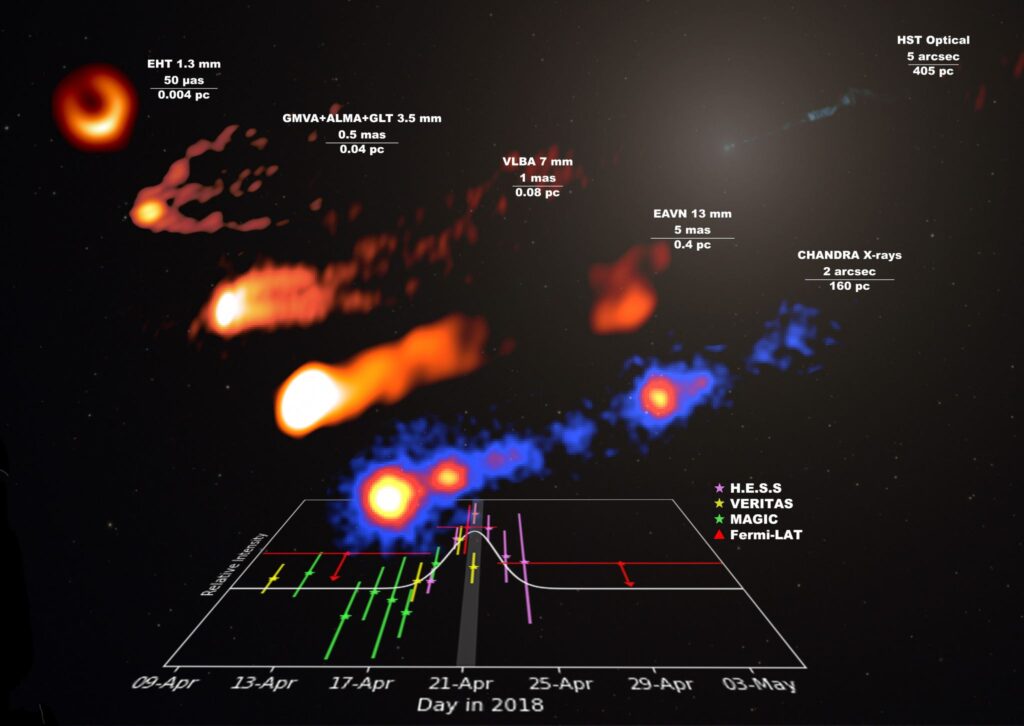In April 2019, the Event Horizon Telescope (EHT) collaboration captured the world’s attention with the first-ever image of a black hole, unveiling the glowing accretion disk of the supermassive black hole (SMBH) at the heart of galaxy M87. Now, this same cosmic powerhouse has delivered another groundbreaking moment. In a multi-wavelength observation campaign, astronomers detected a rare and powerful gamma-ray flare emanating from M87’s relativistic jet—an event that sheds light on the mysteries surrounding black holes and their incredible energy dynamics.
The Gamma-Ray Flare: A Rare Celestial Spectacle
Astronomers recently observed a high-energy gamma-ray flare erupting from M87’s SMBH, the first such event in over a decade. These flares, though rare, provide an extraordinary opportunity to study the energetic processes near black holes. During the April 2018 observational campaign, a collaborative effort between over 25 global facilities, including NASA’s Fermi Gamma-ray Space Telescope and the Hubble Space Telescope, unveiled this intense flare. The flare persisted for three days and originated from a region spanning approximately three light-days—170 times the distance between Earth and the Sun.
The gamma-ray flare’s energy was unprecedented, far exceeding typical emissions from black holes. The variation in the position angle of the photon ring, coupled with asymmetries in the black hole’s event horizon, hinted at dynamic processes fueling this phenomenon.
How Astronomers Captured This Cosmic Event
Detecting such an event required a symphony of cutting-edge instruments working together. The EHT leveraged data from a vast array of telescopes, including space-based observatories like Chandra and NuSTAR, and ground-based facilities such as the Very Energetic Radiation Imaging Telescope Array System (VERITAS). These observatories collected data across multiple wavelengths—radio, optical, X-rays, and gamma rays—to create the most comprehensive view of the flare.

NASA’s Fermi Gamma-ray Space Telescope played a pivotal role, detecting a significant increase in high-energy gamma rays through its Large Area Telescope (LAT). This data was complemented by X-ray observations from Chandra, which revealed intricate details of the jet’s structure, and radio observations from the East Asia VLBI Network, providing insight into the relativistic jet’s behavior.
The Physics Behind the Flare
Black holes are enigmatic powerhouses that exert immense gravitational forces, pulling in surrounding gas and dust into an accretion disk. As material spirals closer, it heats up and emits radiation. In the case of M87, the SMBH is further characterized by its relativistic jet—a high-speed stream of charged particles ejected along the black hole’s axis of rotation.
The observed gamma-ray flare is believed to result from particle acceleration within this jet. These particles interact with magnetic fields and surrounding material, producing high-energy radiation. The asymmetry in the black hole’s photon ring, noted during the flare, suggests a connection between the event horizon’s dynamic structure and the flare’s origin.
Future Prospects in Black Hole Research
The gamma-ray flare from M87 opens the door to numerous research opportunities. Future EHT observations, equipped with enhanced sensitivity, aim to delve deeper into the disk-jet connection and the origins of gamma-ray photon emissions. Theoretical models will also be refined to account for the complex dynamics observed during the flare.
This discovery highlights the potential of legacy data combined with innovative techniques. By reanalyzing archival observations with modern methods, scientists can uncover hidden details, paving the way for groundbreaking findings in astrophysics.
Bridging the Cosmic Gap: Connecting Theory to Observation
For decades, the physics of black holes and their jets has posed a challenge to astronomers. The recent gamma-ray flare offers a rare glimpse into the processes that govern these enigmatic objects. It provides observational evidence to test and refine theories about particle acceleration and energy distribution in relativistic jets.
Conclusion: Illuminating the Universe’s Brightest Mysteries
The gamma-ray flare from M87’s supermassive black hole is a testament to the power of collaboration and innovation in astronomy. It showcases the potential of global partnerships and multi-wavelength campaigns to unravel the universe’s most profound mysteries.
Reference:
![A Hubble Space Telescope image of the giant galaxy M87 shows a 3,000-light-year-long jet of plasma blasting from the galaxy's 6.5-billion-solar-mass central black hole. The blowtorch-like jet seems to cause stars to erupt along its trajectory. These novae are not caught inside the jet, but are apparently in a dangerous neighbourhood nearby. During a recent 9-month survey, astronomers using Hubble found twice as many of these novae going off near the jet as elsewhere in the galaxy. The galaxy is the home of several trillion stars and thousands of star-like globular star clusters. [Image description: A Hubble photo of galaxy M87, which resembles a translucent, fuzzy white cotton ball. The brightness decreases gradually out in all directions from a bright white point of light at the centre. A wavy blue-white jet of material extends from the point-like core outward to the upper right, about halfway across the galaxy. Stars speckle the background.]](https://nasaspacenews.com/wp-content/uploads/2024/12/Hubble_s_view_of_M87_galaxy-2000x1200-1-360x180.jpg)













![A Hubble Space Telescope image of the giant galaxy M87 shows a 3,000-light-year-long jet of plasma blasting from the galaxy's 6.5-billion-solar-mass central black hole. The blowtorch-like jet seems to cause stars to erupt along its trajectory. These novae are not caught inside the jet, but are apparently in a dangerous neighbourhood nearby. During a recent 9-month survey, astronomers using Hubble found twice as many of these novae going off near the jet as elsewhere in the galaxy. The galaxy is the home of several trillion stars and thousands of star-like globular star clusters. [Image description: A Hubble photo of galaxy M87, which resembles a translucent, fuzzy white cotton ball. The brightness decreases gradually out in all directions from a bright white point of light at the centre. A wavy blue-white jet of material extends from the point-like core outward to the upper right, about halfway across the galaxy. Stars speckle the background.]](https://nasaspacenews.com/wp-content/uploads/2024/12/Hubble_s_view_of_M87_galaxy-2000x1200-1-750x375.jpg)




